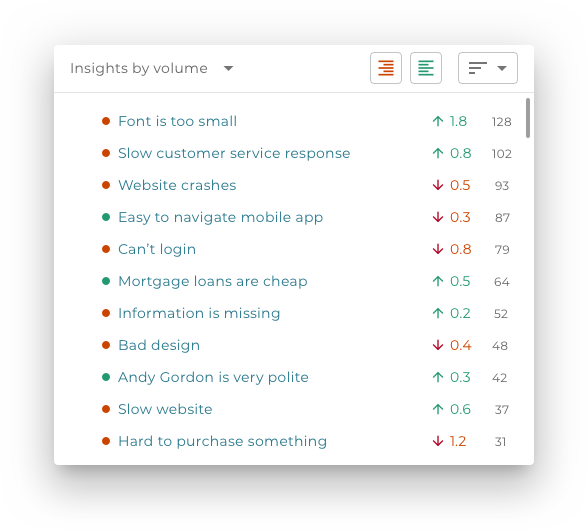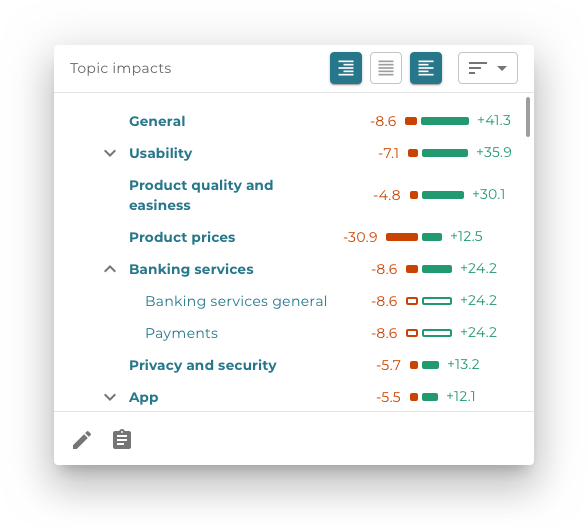Table of contents
1. Shorter surveys and capturing what really matters
2. Getting help from AI
3. Getting unbiased feedback
4. Basics of good surveying remain unchanged
5. Different use cases for AI in market research
6. Summary
1. Shorter surveys and capturing what really matters
We all know the ten-page surveys that some companies have. They hope to capture every aspect of the relationship they have with you. And the feeling of being annoyed with the questions as many of them are hard to answer, and you might even feel being forced to rate aspects you don’t either have no experience with or can’t remember. Then when the open-ended question comes at the end of the survey, you actually end up writing “make shorter surveys!”, rather than something that would actually help the company to improve their customer experience.
I’m not saying you should never make long surveys. But you should definitely be very careful with them. And if you’re systematically collecting feedback at different parts of your customers journey, you will quickly notice you will no longer need them.
2. Getting help from AI
Designing shorter surveys is also where AI can help you. As you no longer need to worry about analysing open-ended responses, you can actually simply ask your customers or users the question in your mind, and let AI analyse and categorise the answers for you. AI will also tell you what you’re doing well, and where you need to improve. And even summarise the results in a way that enables you to easily prioritise the actions to take.
Asking a simple open ended question from customers also means you better capture what really matters. You capture the points your customer would actually tell their friends and family. And the things that would actually impact their purchase decision. How? With AI, when you ask: “How likely would you be to recommend our product to your friends and family?”, and “Why?”, your customers will tell you the things they actually care about. And those are the main things you should also care about. If you ask them the question right after they visit your website, if there is an issue with the speed of the website, they will tell you that—if it matters. Without you specifically asking about it.

Beyond topics, AI can also identify the most common actionable sentences that people mention (source: Lumoa).
3. Getting unbiased feedback
When you’re using AI to analyse open-ended feedback, one key thing to remember is that if you have a sentiment / bias in your original question, it will also impact the sentiment of the answers, and also the way AI can be used to analyse the results. For example, if you ask “How satisfied were you with your experience with our product on a scale 1-5”, and then direct people to answer either “Why are you happy” or “Why are you unhappy” based on the rating they gave, you primarily get feedback from happy customers on why they are satisfied, and from unhappy on why they are dissatisfied.
The main reason for asking the questions this way has been to make it easier to analyse the answers. However, if you have advanced AI in use, it will spot not only the topics mentioned, but also sentiment. And thus you can just simply ask “why did you give this rating” and also capture topics your unhappy customers are happy with, and the other way around.
AI also means you often don’t have to specifically ask a separate “How can we improve?” question, as the main satisfaction question to large extent reveals also the improvement ideas. AI can even capture from feedback the suggestions that people have, examples of problem situations, or even contact requests. That said, sometimes asking a separate improvement question can of course further encourage your customers to ideate. They can come up with ideas that help you in developing your product or service. And naturally AI can help you analyse those answers as well.

AI will automatically detect topics and sentiment from open feedback (source: Lumoa).
4. Basics of good surveying remain unchanged
Some things have not changed. You still have to make sure you understand your customer journey and have made a holistic plan on how to best capture the insights relevant to improve each part of the customer journey. For example, if you want to get insights on how easy it’s to find information to support making a purchase on your website, you should ask about the customers’ overall experience right after they have visited your website with the purpose of purchasing. Make sure you target both, those who made a purchase and those who left without making one.
If you want to understand how your product is fulfilling its purpose, you have to allow customers enough time to actually experience the product before you ask for their feedback. This means that asking feedback on a smoothie versus a sofa should happen within a different timeframe of the original purchase. You can read more about understanding your customer journey here.
Another unchanged aspect is the need for consistency. Consistency of questions and when you ask them enables you to be systematic in improving, and to also track the impact of the improvements you’re making. When you ask for feedback systematically, AI will help you identify opportunities to improve, and also will tell you if your actions are having the desired effect. Solutions like Lumoa can immediately highlight new trending insights, and show how positive and negative feedback on specific topics are evolving over time.

Consistent collecting of feedback helps you spot trends for different topics (source: Lumoa).
5. Different use cases for AI in market research
AI can help significantly in analysing results of any kind of surveys, whether they are satisfaction surveys (such as CSAT or NPS), product research, or brand research. In product research, a typical use case could be asking test users to list what they like about a product, and what they dislike. AI can then be used to automatically summarise the results and tell exactly in how many answers some characteristic of the product is being mentioned. Additionally, AI can also spot patterns, such as if a person mentions “design” what other topics they are likely to mention.
In brand research one of my favourite use cases for AI is investigating top of the mind brands. You can simply ask people “What is your favourite shoe brand?” and let them list the ones in their mind. Traditionally either analysing these results have been really time consuming, or then researchers have used pre-curated lists where people can check the favourite brands. This approach may however skew the results as the research is already sparking the memory of the person, and also if there’s a new emerging brand, you might miss it entirely.
6. Summary
In summary, using AI based topic modelling and sentiment analysis means that you can
- have shorter surveys.
- better capture what really matters to your customers.
To capture the above benefits, you should make sure to
- ask for feedback at the right time.
- keep questions unbiased.
- be consistent with collecting feedback.
Would you like to learn how AI can help you to get insights and eliminate manual work in analysing unstructured feedback? Watch Lumoa webinar “Surveys: How to avoid pitfalls and take advantage of AI” or sign up for a free trial of Lumoa’s AI platform.

